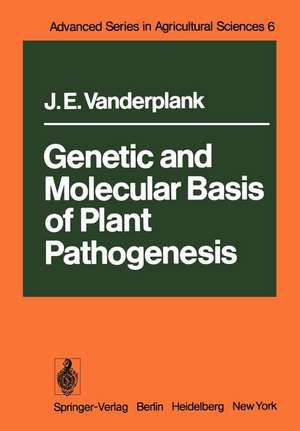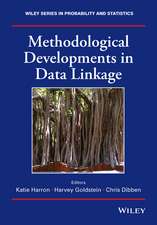Genetic and Molecular Basis of Plant Pathogenesis: Advanced Series in Agricultural Sciences, cartea 6
Autor J. E. Vanderplanken Limba Engleză Paperback – 16 dec 2011
Din seria Advanced Series in Agricultural Sciences
- 15%
 Preț: 648.89 lei
Preț: 648.89 lei - 15%
 Preț: 640.06 lei
Preț: 640.06 lei - 15%
 Preț: 645.14 lei
Preț: 645.14 lei - 18%
 Preț: 887.05 lei
Preț: 887.05 lei - 15%
 Preț: 640.55 lei
Preț: 640.55 lei - 15%
 Preț: 637.93 lei
Preț: 637.93 lei - 15%
 Preț: 642.83 lei
Preț: 642.83 lei - 15%
 Preț: 641.53 lei
Preț: 641.53 lei - 15%
 Preț: 637.59 lei
Preț: 637.59 lei - 15%
 Preț: 653.46 lei
Preț: 653.46 lei - 15%
 Preț: 638.57 lei
Preț: 638.57 lei - 20%
 Preț: 546.85 lei
Preț: 546.85 lei - 15%
 Preț: 642.18 lei
Preț: 642.18 lei - 18%
 Preț: 888.49 lei
Preț: 888.49 lei - 15%
 Preț: 642.68 lei
Preț: 642.68 lei - 15%
 Preț: 643.48 lei
Preț: 643.48 lei - 15%
 Preț: 636.45 lei
Preț: 636.45 lei - 20%
 Preț: 553.61 lei
Preț: 553.61 lei - 15%
 Preț: 644.49 lei
Preț: 644.49 lei - 15%
 Preț: 656.58 lei
Preț: 656.58 lei - 15%
 Preț: 634.00 lei
Preț: 634.00 lei -
 Preț: 382.18 lei
Preț: 382.18 lei - 18%
 Preț: 890.54 lei
Preț: 890.54 lei
Preț: 940.72 lei
Preț vechi: 1147.21 lei
-18% Nou
Puncte Express: 1411
Preț estimativ în valută:
180.03€ • 195.48$ • 151.22£
180.03€ • 195.48$ • 151.22£
Carte tipărită la comandă
Livrare economică 23 aprilie-07 mai
Preluare comenzi: 021 569.72.76
Specificații
ISBN-13: 9783642669675
ISBN-10: 3642669670
Pagini: 188
Ilustrații: XII, 170 p.
Dimensiuni: 170 x 244 x 10 mm
Greutate: 0.31 kg
Ediția:Softcover reprint of the original 1st ed. 1978
Editura: Springer Berlin, Heidelberg
Colecția Springer
Seria Advanced Series in Agricultural Sciences
Locul publicării:Berlin, Heidelberg, Germany
ISBN-10: 3642669670
Pagini: 188
Ilustrații: XII, 170 p.
Dimensiuni: 170 x 244 x 10 mm
Greutate: 0.31 kg
Ediția:Softcover reprint of the original 1st ed. 1978
Editura: Springer Berlin, Heidelberg
Colecția Springer
Seria Advanced Series in Agricultural Sciences
Locul publicării:Berlin, Heidelberg, Germany
Public țintă
ResearchCuprins
1 Variation in the Resistance of the Host and in the Pathogenicity of the Parasite.- 1.1 Introduction.- 1.2 Systems of Variation.- 1.3 Vertical Resistance with Host-Pathogen Specificity.- 1.4 Vertical Resistance Without Host-Pathogen Specificity.- 1.5 Epidemiological Consequence of Nonspecific Vertical Resistance.- 1.6 Vertical Resistance Without Hypersensitivity.- 1.7 Correlated Variation in Host and Pathogen.- 1.8 Uncorrelated Variation in Horizontal Resistance.- 1.9 Absence of a Host-Pathogen Differential Interaction in Horizontal Resistance.- 1.10 Uniform Ranking Order in Horizontal Resistance.- 1.11 Tests for Vertical and Horizontal Resistance.- 2 The Gene-for-Gene and the Protein-for-Protein Hypotheses.- 2.1 Introduction.- 2.2 Why Proteins? Why Polymerization?.- 2.3 Flor’s Gene-for-Gene Hypothesis.- 2.4 The Living Host Cell Nucleus in Compatible Gene-for-Gene Combinations.- 2.5 The Gene for Susceptibility and Its Different Roles.- 2.6 Comments Arising from the Possibility of Tandem Duplication.- 2.7 The Gene for Avirulence and Its Different Roles.- 2.8 Susceptibility and Resistance. Neutral Mutation.- 2.9 Avirulence and Virulence.- 2.10 Isozymes.- 2.11 The Hydrophobic Effect. Amino Acids with Hydrophobic Side Chains. Their Interrelated Genetic Codes.- 2.12 Amino Acids with Hydrophilic Side Chains. Their Part in Catalysis.- 2.13 Protein Structures.- 2.14 Protein-Protein Recognition.- 3 The Protein-for-Protein Hypothesis: Temperature Effects and Other Matters.- 3.1 Introduction.- 3.2 The Thermodynamic Problem.- 3.3 Inactivation of Protein Monomers.- 3.4 Effect of Temperature on Resistance to Wheat and Oat Stem Rust and Oat Crown Rust.- 3.5 Temperature and Infection of Tomato Plants by Tobacco Mosaic Virus.- 3.6 The Temperature Effect in Some Other Diseases.- 3.7Some Seemingly Anomolous Examples Considered.- 3.8 Temperature Reversal.- 3.9 Conditional Responses to Temperature. Dominance of Resistance as a Test.- 3.10 Protein Polymerization and the Solvent.- 3.11 Osmotic Pressure Differences.- 3.12 Analytical Difficulties Arising from Procedures.- 3.13 Isozymes and Electrophoresis.- 3.14 A Hypothesis About Susceptibility and Resistance.- 3.15 Feeding the Pathogen. Function of Genes for Avirulence.- 3.16 In Fungus Disease, is Wound Protein the Host Protein Involved? The Function of Genes for Susceptibility.- 3.17 Autoregulation of Gene Expression.- 3.18 A Corollary.- 3.19 Comparison with Antigen-Antibody Systems.- 3.20 Peroxidase Production in Infected Susceptible Plants.- 3.21 The Lag Phase in the Resistance Reaction.- 3.22 Uniformity in Resistance Reaction Types. Secondary Effects.- 3.23 Temperature Limits Again. The Genes Sr6 and Sr 11. Effect of Ethylene.- 3.24 In Virus Disease, Is RNA Replicase the Protein Involved?.- 3.25 Summary and Conclusions.- 3.26 Identifying Gene-for-Gene Disease.- 4 Common Antigenic Surfaces in Host and Pathogen.- 4.1 Introduction.- 4.2 Common Antigens in the Flax-Flax Rust System and Some Other Systems.- 4.3 Coexistence of Complementary and Similar Surfaces.- 4.4 The Intrinsic Experimental Difficulty.- 4.5 Alternative Hypotheses About Common Antigens.- 4.6 Common Antigenic Determinants in Other Than Gene-for-Gene Systems.- 4.7 Common Antigens and Male-Female Recognition in Plants.- 5 Other Large Molecules in Relation to Gene-for-Gene Disease.- 5.1 Introduction.- 5.2 DNA.- 5.3 RNA.- 5.4 Glycoproteins.- 5.4.1 The Nature of Glycoproteins.- 5.4.2 Membranes and Membrane Glycoproteins.- 5.4.3 The Carbohydrate Determinants of the AB0 Blood Cell Types.- 5.4.4 One Gene-One Glycosidic Linkage Hypothesis.- 5.4.5 Glycoproteins and the Elicitor Hypothesis.- 5.4.6 An Active Glycoprotein from Phytophthora megasperma var. sojae.- 5.4.7 A Thermodynamic Objection.- 5.4.8 Elicitors Are Unspecific.- 5.5 Polysaccharides.- 5.6 Lectins.- 5.7 Phytoalexins.- 6 Population Genetics of the Pathogen.- 6.1 Introduction.- 6.2 Directional Selection Towards Virulence.- 6.3 Stabilizing Selection Against Virulence.- 6.4 Nonallelic Virulence Interaction in Stabilizing Selection.- 6.5 The Environmental Effect in Nonallelic Interaction Between Virulence on Genes Sr6 and Sr9d.- 6.6 Dissociation of Virulence Through Repulsion.- 6.7 Association of Virulence as an Indirect Consequence of Repulsion.- 6.8 Evidence for Nonallelic Virulence Interactions in Some Other Diseases.- 6.9 A Hypothesis About the Nonallelic Virulence Interaction.- 6.10 The Second Gene-for-Gene Hypothesis.- 6.11 The Commonness of Weak Resistance Genes.- 6.12 The Use of Weak Resistance Genes.- 6.13 The Gap in the Use of Vertical Resistance in Plant Breeding.- 6.14 A Guide to the Use of Vertical Resistance.- 6.15 How to Improve the Performance of Vertical Resistance.- 6.16 The Durability of Vertical Resistance.- 6.17 The Effect of Vertical Resistance on Epidemics.- 7 Horizontal Resistance to Disease.- 7.1 Introduction.- 7.2 Horizontal Resistance Not Disguised Vertical Resistance.- 7.2.1 Hypothesis That Horizontal Resistance Is Buried Vertical Resistance.- 7.2.2 Hypothesis That Horizontal Resistance Is Massed Vertical Resistance.- 7.3 Examples of the Rapid Accumulation of Horizontal Resistance.- 7.4 Polygenic Inheritance.- 7.4.1 Confusion About Polygenes.- 7.4.2 Discontinuous Variation and Qualitative Characters; Continuous Variation and Quantitative Characters.- 7.4.3 Polygenic Variation.- 7.4.4 The Untrue Converse.- 7.5 The Number of Genes Conditioning Horizontal Resistance.- 7.6 The Anonymity of Horizontal Resistance Genes.- 7.7 Specificity in Horizontal Resistance.- 7.8 The Vertifolia Effect.- 7.9 Resistance and Loss of Fitness.- 7.10 Epidemiological Effects of Horizontal Resistance.- 7.10.1 Effect on the Infection Rate.- 7.10.2 Delay of the Start of an Epidemic.- 7.10.3 Contraction of the Scale of Spread of an Epidemic.- 8 Selective Pathotoxins in Host-Pathogen Specificity.- 8.1 Introduction.- 8.2 Some Diseases Caused by Selective Pathotoxins.- 8.2.1 Victoria Blight of Oats.- 8.2.2 Southern Maize Leaf Blight.- 8.2.3 Eye Spot Disease of Sugarcane.- 8.3 Selective Pathotoxins Unconnected with Gene-for-Gene Systems.- 8.4 Evidence for Horizontal Resistance.- 8.5 Horizontal Resistance with a Threshold.- 9 A Molecular Hypothesis of Vertical and Horizontal Resistance.- 9.1 The Hypothesis.- 9.2 Catalysis the Transformer and Eroder of Qualitative Variation.- 9.3 Vertical Resistance: Qualitative Variation.- 9.4 Horizontal Resistance: Quantitative Variation.- 9.5 Vertical Resistance: Reciprocal Host-Pathogen Variation in the Same Class.- 9.6 Horizontal Resistance: Host-Pathogen Variation of Different Kinds.- 10 Biotrophy, Necrotrophy, and the Lineage of Symbiosis.- 10.1 Introduction.- 10.2 Necrotrophy, Biotrophy, and Biotrophy-Necrotrophy Sequences.- 10.3 The Lineage of Symbiosis.- References.















